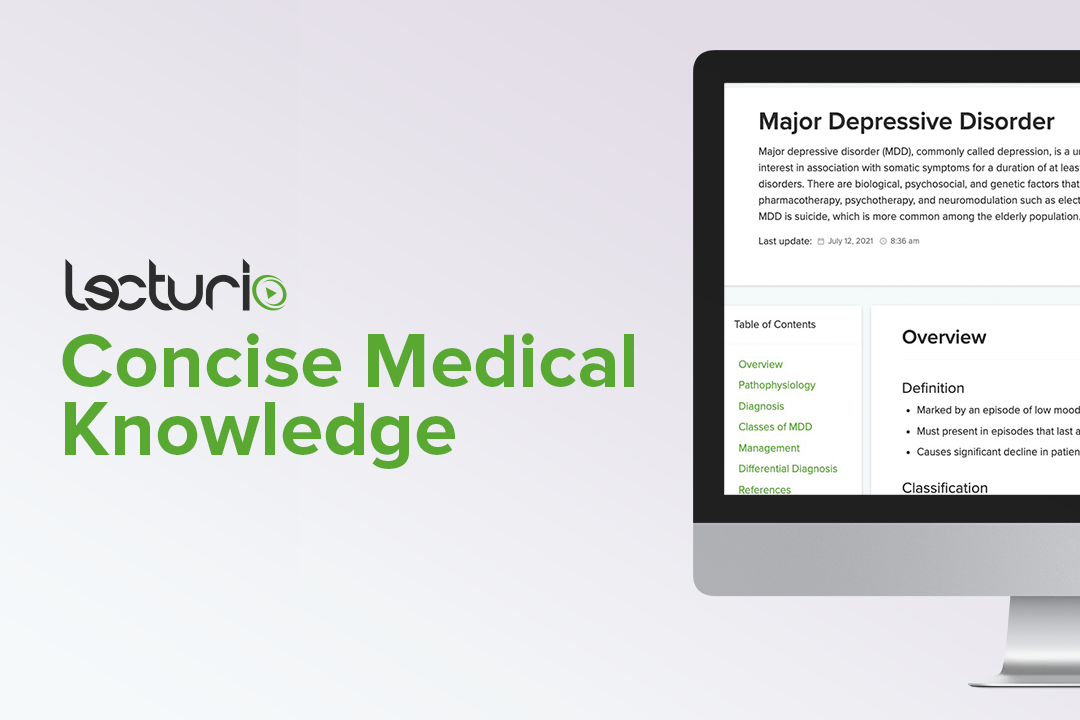Playlist
Show Playlist
Hide Playlist
Depression: Screening and Treatment
-
Slides Depression.pdf
-
Download Lecture Overview
00:01 It is extremely important to screen for suicide risk at every encounter with a patient. 00:08 Because the suicide risk assessment is so important, I want you to pay particular attention to this slide. 00:15 So the chronic risk factors, a few of them include patient’s age previous suicide attempts, ownership of guns or weapons, race or ethnicity, family history of suicide attempts. 00:29 Some modifiable risk factors are patients’ mental illness, physical illness, substance abuse, connection to treatment and their support network. 00:38 And then also consider protective factors. 00:40 They may be finances, education, religion, family or friends, employment, pets, et cetera. 00:48 So I want to ask you what percentage of patients with major depression will go on to experience a second episode of depression? Here’s what we think. 01:00 About half of people who’ve had one episode of major depression will experience a second. 01:06 We think that 70% of those of who have experienced two episodes will have a third episode of depression and we tend to think that about 90% of those people who have experienced three or more lifetime episodes of depression are going to have another event. 01:23 So this is very important as you consider treatment recommendations and management plans for your patient. 01:30 Children are an interesting subset and they’re also susceptible to depression. 01:36 It’s important to note that a child may not come to the doctor or their parent complaining of a low mood or depression, they can’t quite put words to what they’re feeling. 01:45 So instead, they may just seem very irritable or angry and that’s an important thing to look out for in a child who comes to the office visit. 01:54 So any child who’s looking irritable might actually be a sign of depression. 01:59 And the elderly are another subset that need particular attention because major depression is actually very common and it affects them, too. 02:08 The elderly are twice as likely to commit suicide than the general population and depressed symptoms have been found in about 15% of nursing home residents. 02:19 So it’s pretty pervasive. 02:22 These symptoms of depression will often in the elderly look a little bit different. 02:27 So, here, the presenting complaint may be a memory problem or a new onset cognitive problem. 02:34 Therefore, they are at risk for being written off as having dementia. 02:39 So any elderly patient who presents with poor concentration or focus or any changes in their cognition really needs to be screened for depression. 02:49 And the term for this is actually pseudodementia. 02:55 There are a lot of different treatment options for depression. 02:58 One of the first things you have to consider is the level of care that a patient needs. 03:03 So we think about hospitalization as being the safest place for the patient who is unable to safely take care of themselves in the community because their depression has gotten so bad. 03:16 So any patient at risk of harm to themselves or others or a patient who can’t meet their day to day needs may need to be hospitalized. 03:25 Otherwise, you might opt to treat your patient in the outpatient setting. 03:30 Pharmacotherapy is also extremely important. 03:33 We’re going to touch on that briefly in this lecture and then you can followup with another lecture specifically dedicated to pharmacotherapy and depression. 03:43 It includes everything from antidepressants to stimulants to even antipsychotic medications, anxiolytics and mood stabilizers. 03:53 A little bit more about hospitalization. 03:56 There are a couple of options. 03:57 So we talked before about patients needing to go to the hospital because of a safety risk. 04:02 That’s called involuntary admission. 04:05 And the involuntary admission is permitted only when an individual poses a serious risk of threat to harm to themselves or others. 04:13 And the goal there is the acute safety and stabilization of the patient. 04:18 There’s always an option for somebody to go into the hospital voluntarily. 04:22 And that’s where a patient will recognize they need a lot more help and they ask to go in so they can receive treatment from doctors, nurses and social workers, maybe in an effort to help establish a good outpatient care plan. 04:36 Otherwise most patients with depression are actually managed in the outpatient care setting. 04:41 A quick overview of the pharmacotherapy for depression. 04:44 It can include antidepressants such as selective serotonin reuptake inhibitors or SSRIs, tricyclic antidepressants, monoamine oxidase inhibitors. 04:55 There can also be other medications like stimulants, and these are often helpful especially in people who are elderly or the terminally ill. 05:05 Think of that group who have very low energy and low motivation. 05:09 That’s where a stimulant might actually help to perk them up a little bit. 05:12 Antipsychotics can be helpful in some cases of depression, especially in people who have psychotic features or features of catatonia and there are other options as well. 05:24 You want to make sure general medical treatments are being addressed, even a little extra thyroid treatment can go a long way in terms of helping someone with depression. 05:34 All antidepressant medications are pretty much equally effective but they differ in terms of their side effect profile and that’s usually what you need to consider when making a recommendation. 05:44 Also, it’s important to tell your patient that these medicines can take about four to eight weeks before they actually start to work. 05:51 So that way, your patient won’t just give up on the medicine and they’ll persist in taking it. 05:56 A side effect that can be very serious from antidepressant medications that’s worth noting is something called serotonin syndrome. 06:05 And this is marked by autonomic instability, hyperthermia, and seizures. 06:10 It can actually result in coma or death. 06:13 So serotonin syndrome can result when somebody’s on, say too high of a dose of an SSRI or they’re on multiple SSRIs at one time. 06:22 It can also result from combining medications like an SSRI with a monoamine oxidase inhibitor or an SNRI, another medication that boosts serotonin and norepinephrine. 06:36 If you combine that with a monoamine oxidase inhibitor, there’s also a very high risk for serotonin syndrome. 06:43 So it’s important when prescribing medication to always share with your patient risks and benefits and make sure that you’re being attentive to how their physically tolerating the medicine. 06:53 There’s also psychotherapy, which is extremely helpful especially in combination with pharmacotherapy. 07:00 There’s a wide array of psychotherapies that can help your patient. 07:04 These range from behavioral to cognitive, supportive, family therapy, and again in combination with medication management is extremely valuable. 07:15 ECT otherwise known as electroconvulsive therapy is also a very useful treatment in depression. 07:24 This is specifically used for people who have treatment resistant depression, so somebody who’s maybe tried three antidepressants and hasn’t had a positive effect from them. 07:34 There are other indications for ECT as well such as catatonic features and sometimes mixed episodes. 07:42 ECT is actually quite safe, it’s done under general anesthesia in an operating room or surgical suite. 07:49 And while a small controlled seizure is delivered to the patient, it’s done in a very controlled setting where their blood pressure and heart rate is monitored and an anaesthesiologist is actually putting the patient to sleep and very temporarily paralysing their muscles. 08:08 So when that seizure occurs, the patient doesn’t have a huge grand mal seizure, but rather their body doesn’t move and all the activity is really limited to the region of the brain that we’re hoping to target. 08:21 Usually , a patient will go through a course of about eight to ten ECT treatments and then sometimes have maintenance beyond that, meaning once monthly ECT to help sustain the positive benefits. 08:35 A common side effect of ECT is retrograde amnesia, something very important to remember and inform your patients about. 08:43 So we summarized here a little bit about depression, the various types of it, the diagnosis, and some treatment options.
About the Lecture
The lecture Depression: Screening and Treatment by Helen Farrell, MD is from the course Mood Disorders. It contains the following chapters:
- Screening
- Treatment for Depression
- Psychotherapy
Included Quiz Questions
What percentage of people with 2 previous episodes of major depression are more likely to experience a third one?
- 70%
- 40%
- 80%
- 60%
- 50%
Which of the following statements regarding depression in elderly patients is TRUE?
- The symptoms can be mistaken with memory and cognitive disturbances related to aging.
- They are twice less likely to commit suicide as the general population.
- It often presents as irritability instead of low mood.
- Depression is present in 50% of the nursing home residents.
- It requires underlying dementia for diagnosis.
Which of the following groups of drugs is NOT useful in the management of depression?
- Dopamine inhibitors
- Antipsychotics
- Selective serotonin reuptake inhibitors
- Monoamine oxidase inhibitors
- Tricyclic antidepressants
Which of the following statements regarding serotonin syndrome is FALSE?
- Hypothermia is one of its hallmarks.
- It is seen when monoamine oxidase inhibitors and selective norepinephrine reuptake inhibitors are used together.
- The patient often presents with seizures.
- It can also result in coma and death.
- It can occur when the patient is on a high dose of an SSRI.
When is Electro Convulsive Therapy (ECT) indicated as a treatment modality?
- When the patient presents with catatonia
- Only when an adjunctive mood stabilizer is given
- It's offered as first-line therapy in all cases of major depression.
- Patients not responding to one anti-depressant.
- It's given to all cases of depression, even those responsive to antidepressant therapy.
Customer reviews
5,0 of 5 stars
| 5 Stars |
|
5 |
| 4 Stars |
|
0 |
| 3 Stars |
|
0 |
| 2 Stars |
|
0 |
| 1 Star |
|
0 |




